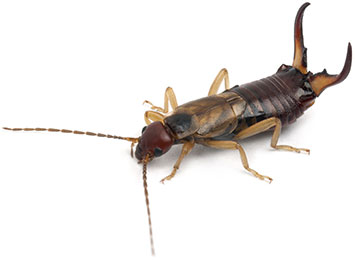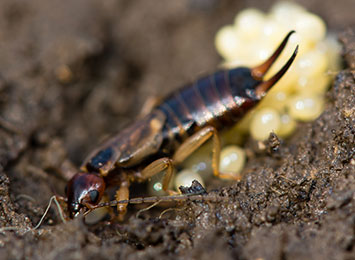Earwigs are almost universally regarded as gross and creepy bugs, but they’re actually beneficial to their environment; they eat detritus, or dead plant and animal matter, and contribute to natural decay. Still, if they cause problems for people, it’s best to have them taken care of.
Through preventative pest control, the pros at Assured Environments can help remove earwigs from your property. With pest exclusion services, we can help make sure they don’t come back.
Earwig Control Services
Earwig Identification

What do Earwigs Look Like?
Size: Around 16 millimeters long (or ⅝ inches)
Color: Reddish brown to dark brown with brighter, yellow-brown legs.
Earwigs have a large set of forceps-like pincers called cerci located on the tip of their abdomens (rear, opposite their heads). Earwigs use their cerci to hunt for food and defend themselves.
Believe it or not, most earwigs have wings and are capable of limited flight. Their name references these wings, which are shaped like a human ear when unfolded in flight. They’re not very good at flying, though, so they usually stay on the ground.
Signs of an Earwig Infestation
If you have a garden or ornamental plants, look for small bite marks on the leaves or flower buds. These bite marks may be circular on the inner part of a leaf or flower bud or look like fraying on the outer edges.
Earwigs secrete a foul-smelling liquid when threatened or crushed, so if you have an unidentified smell outside or around your building, look for earwigs. The secreted liquid can also stain cloth and carpeting if left alone.

Earwig Control and Prevention
Just like any other pest infestation, prevention is the best practice. Practice regular yard maintenance. Reduce the natural debris earwigs can hide under to deprive them of places to stay out of the heat. Remove rotting or dying plants, fallen leaves, piles of lumber, and excess mulch. Look for ways to reduce the humidity around your building.
Minimize moisture and humidity both in and outside of your building. Keep an eye on your downspouts, gutters, and other irrigation systems to prevent water buildup after rain. Ventilate crawl spaces properly. Look for sources of moisture inside your building and correct them.
Earwig Diet and Behavior
Most species of earwig are omnivorous. As mentioned earlier, they mostly eat detritus – dead plant and animal material. Earwigs are considered a crop pest because they feed on seedlings, corn silk and ears, cauliflower heads, chard, and several other varieties of flowering crop plants.
Earwigs are nocturnal and sensitive to heat and dryness. They hide in dark, damp locations during the day and only become active at night. In dry environments or during hot seasons, earwigs seek out confined, dark, and wet locations, such as the inside of plant life or under potted plants, to survive.
Reproduction and Life Cycle
Adult earwigs reproduce sexually in the late summer or early fall. A fertilized female earwig excavates a special burrow 15mm deep, which she uses to store fertilized eggs. The female deposits 20-60 eggs in the burrow. Eggs take anywhere between 12 to 85 days to hatch depending on temperature.
Earwigs undergo four nymphal “instar” stages broken into two phases: nesting and free foraging. First instar nymphs stay in the nest. Second instar nymphs venture out of the nest at night to seek food. Third and fourth instar nymphs become free-roaming, seeking food and shelter on the surface until adulthood.

Call Assured Environments for Earwig Pest Control
Earwig infestations rarely occur in isolation; if you have a high number of earwigs on your property, you probably have another pest problem underlying it. Whatever the issue is, the Assured Environments team will get to the bottom of it with a comprehensive inspection and customized pest control services.
Give us a call for help addressing your earwig problem! We offer free inspections to get you started.
Natural ways to remove earwigs include spraying a mixture of water and dish soap or a mixture of water and rubbing alcohol in the area where you notice them. The alcohol will kill them quickly. You can also use boric acid, pesticides or traps. Vacuum up the remains.
Earwigs come inside to find food, water and shelter, especially in fall. Landscaping your yard to keep brush and debris away from your home may help. You can also add a border of gravel or stone around your foundation to discourage earwigs and other pests from crossing over.
Bites and pinching are rare. Adult earwigs use their pincers defensively and will clamp down on humans if threatened, but they can’t generate enough force to hurt people.
Earwigs get in the same way most pests do – cracks, screens, vents and other small openings around the perimeter of your homes. Seal these. You can also make your home less inviting by controlling humidity and preventing damp spaces. In your yard, remove brush and leaves where earwigs might hide. Earwigs are nocturnal and attracted to light. Keep outside lights off to make your home less of a target.
Earwigs tend to be solitary creatures. If you encounter and infestation, call a pest control expert for help. It may be a sign of a larger problem.
Probably not. While any small insect is capable of crawling in your ear, most won’t. Earwigs get their name for their ear-shaped wings not their desire to burrow into your head.
In New York, New Jersey and Connecticut, call Assured Environments for all pest concerns. We can identify where earwigs are entering your home and prevent future invasion.

